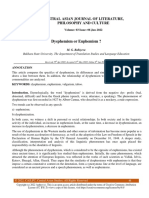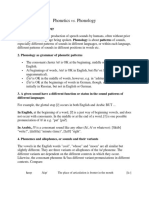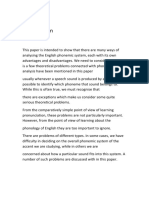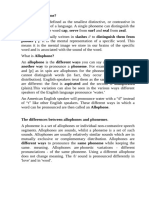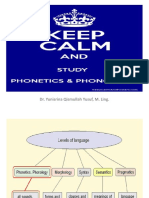Phonetics vs. Phonology
Phonetics vs. Phonology
Uploaded by
Daniel Garzia AizragCopyright:
Available Formats
Phonetics vs. Phonology
Phonetics vs. Phonology
Uploaded by
Daniel Garzia AizragOriginal Description:
Original Title
Copyright
Available Formats
Share this document
Did you find this document useful?
Is this content inappropriate?
Copyright:
Available Formats
Phonetics vs. Phonology
Phonetics vs. Phonology
Uploaded by
Daniel Garzia AizragCopyright:
Available Formats
Phonetics vs.
Phonology
1. Phonetics vs. phonology
Phonetics deals with the production of speech sounds by humans, often without prior
knowledge of the language being spoken. Phonology is about patterns of sounds,
especially different patterns of sounds in different languages, or within each language,
different patterns of sounds in different positions in words etc.
2. Phonology as grammar of phonetic patterns
The consonant cluster /st/ is OK at the beginning, middle or end of words in
English.
At beginnings of words, /str/ is OK in English, but /ftr/ or / tr/ are not (they are
ungrammatical).
/ tr/ is OK in the middle of words, however, e.g. in "ashtray".
/ tr/ is OK at the beginnings of words in German, though, and /ftr/ is OK word-
initially in Russian, but not in English or German.
3. A given sound have a different function or status in the sound patterns of
different languages
For example, the glottal stop [ ] occurs in both English and Arabic BUT ...
In English, at the beginning of a word, [ ] is a just way of beginning vowels, and does
not occur with consonants. In the middle or at the end of a word, [ ] is one possible
pronunciation of /t/ in e.g. "pat" [pa ].
In Arabic, / / is a consonant sound like any other (/k/, /t/ or whatever): [ íktib] "write!",
[da íi a] "minute (time)", [ a ] "right".
4. Phonemes and allophones, or sounds and their variants
The vowels in the English words "cool", "whose" and "moon" are all similar but slightly
different. They are three variants or allophones of the /u/ phoneme. The different
variants are dependent on the different contexts in which they occur. Likewise, the
consonant phoneme /k/ has different variant pronunciations in different contexts.
Compare:
The place of articulation is fronter in the
keep /kip/ [k+h]
mouth
The place of articulation is not so front in
cart /k t/ [kh]
the mouth
The place of articulation is backer, and
coot /kut/ [khw]
the lips are rounded
There is less aspiration than in initial
seek /sik/ [k`]
position
scoop /skup/ There is no aspiration after /s/ [k]
These are all examples of variants according to position (contextual variants). There are
also variants between speakers and dialects. For example, "toad" may be pronounced
[tëUd] in high-register RP, [toUd] or [to d] in the North. All of them are different
pronunciations of the same sequence of phonemes. But these differences can lead to
confusion: [toUd] is "toad" in one dialect, but may be "told" in another.
5. Phonological systems
Phonology is not just (or even mainly) concerned with categories or objects (such as
consonants, vowels, phonemes, allophones, etc.) but is also crucially about relations.
For example, the English stops and fricatives can be grouped into related pairs which
differ in voicing and (for the stops) aspiration:
Voiceless/aspi p t k f s h
rated h h h
Voiced/unaspi (unpair
b d v z ð
rated ed)
Patterns lead to expectations: we expect the voiceless fricative [h] to be paired with a
voiced [ ], but we do not find this sound as a distinctive phoneme in English. And in
fact /h/ functions differently from the other voiceless fricatives (it has a different
distribution in words etc.) So even though [h] is phonetically classed as a voiceless
fricative, it is phonologically quite different from /f/, /s/, / / and / /.
Different patterns are found in other languages. In Classical Greek a three-way
distinction was made between stops:
Voiceless/aspirated ph th kh
Voiced/unaspirated p t k
Voiced (and unaspirated) b d
In Hindi-Urdu a four-way pattern is found, at five places of articulation:
Voiceless aspirated ph th h ch kh
Voiceless unaspirated p t c k
Voiced unaspirated b d etc.
Breathy voiced ("voiced aspirates") b d etc.
6. Shapes of vowel systems: some common examples:
Triangular: 3 vowels Triangular: 5 vowels
(e.g. Arabic) (e.g. Japanese)
i u i u
e o
a a
Triangular: 6 vowels Triangular: 7 vowels
(e.g. Tübatulabal) (e.g. Italian)
i u i u
e o e o
a a
Triangular: 6 vowels Rectangular: 6 vowels
(e.g. Bulgarian) (e.g. Montenegrin)
i u i u
e o e o
a a
How many degrees of vowel height are there in Bulgarian? On the face of things, it
appears to be not very different from Tübatulabal, which has three heights: three high
vowels, two mid vowels and one low vowel. But if we look more closely into Bulgarian
phonology, we see that the fact that schwa is similar in height to /e/ and /o/ is
coincidental: the distinction that matters in Bulgarian is /i/ vs. /e/, /u/ vs. /o/ and / / vs.
/a/, i.e. relatively high vs. relatively low. As evidence for this statement, note that while
all six vowels may occur in stressed syllables, only /i/, /e/, / / and /u/ occur in
unstressed syllables.
7. Phonology as interpretation of phonetic patterns: Fang (Bantu: Cameroon,
Gabon, Equatorial Guinea)
Fang English Fang English
1) etf - shoulder 7) t m branch
2) v bi, v -bi hippopotamus 8) bik q back teeth
3) ndv ( ) dam 9) el n water tortoise
4) kf -l tortoise 10) f q bag
5) kf -
salt 11) t neck
6) k l rope 12) os n squirrel
You might also like
- Meeting 2 - Language and SoundsDocument37 pagesMeeting 2 - Language and SoundsSommerled100% (1)
- AP Human Geography Chapter 5 NotesDocument15 pagesAP Human Geography Chapter 5 NotesSeth Adler82% (44)
- English Linguistics A Coursebook For Students of EnglishDocument385 pagesEnglish Linguistics A Coursebook For Students of EnglishFélix Camacho Moya100% (11)
- Dysphemism or Euphemism ?Document5 pagesDysphemism or Euphemism ?Central Asian StudiesNo ratings yet
- Branches of PhonologyDocument4 pagesBranches of PhonologyJhon Rey Sumampong100% (1)
- Phonology: The Sound Patterns of Language: LCD 101: Introduction To Language 2011 Fall RyanDocument51 pagesPhonology: The Sound Patterns of Language: LCD 101: Introduction To Language 2011 Fall RyanAmin MofrehNo ratings yet
- Phonetics Vs Phonology by ColemenDocument4 pagesPhonetics Vs Phonology by ColemenDestianNo ratings yet
- Phonetics vs. Phonology: /kip/ The Place of Articulation Is Fronter in (K)Document4 pagesPhonetics vs. Phonology: /kip/ The Place of Articulation Is Fronter in (K)tariqNo ratings yet
- Phonetics and FonologyDocument3 pagesPhonetics and FonologyGeorgett VasquezNo ratings yet
- Phonetics Vs Phonology 1Document3 pagesPhonetics Vs Phonology 1Saheli GuptaNo ratings yet
- Phonetics Vs PHONOLOGYDocument4 pagesPhonetics Vs PHONOLOGYmeymirahNo ratings yet
- Workshop 2Document11 pagesWorkshop 2Ilse AlvarezNo ratings yet
- Linguistics Kelompok 3Document17 pagesLinguistics Kelompok 3Salman Farizi100% (1)
- Phoneme Vs Allophone - CARR-LATESTDocument37 pagesPhoneme Vs Allophone - CARR-LATESTWiddowsonNo ratings yet
- Allophonic Variants For English ConsonantsDocument11 pagesAllophonic Variants For English ConsonantsSergio Vargas0% (1)
- PhonologyDocument31 pagesPhonologyyokaj18372No ratings yet
- Sumary U-4 PhonologyDocument9 pagesSumary U-4 Phonologyv2mgmsd6ghNo ratings yet
- Phonology: The Sound Patterns of Language: Thomas Carlyle (1795-1881) A High School StudentDocument57 pagesPhonology: The Sound Patterns of Language: Thomas Carlyle (1795-1881) A High School StudentAnonymous i437GuqkT4No ratings yet
- Lecture 03 English VowelsDocument14 pagesLecture 03 English VowelsIlyes Karar100% (1)
- IntroductionDocument3 pagesIntroductionتقوى ميسونNo ratings yet
- Segmental Phonology OutlineDocument7 pagesSegmental Phonology Outlinevargas199511No ratings yet
- Booklet 5Document26 pagesBooklet 5MartaNo ratings yet
- Introduction To PhonologyDocument8 pagesIntroduction To PhonologyKhlifibrahimNo ratings yet
- 02 BasicsDocument3 pages02 BasicsHisham SasyNo ratings yet
- Australian EnglishpronounDocument13 pagesAustralian EnglishpronounGamal HalimNo ratings yet
- In PhonologyDocument5 pagesIn Phonologyسہۣۗيزار سہۣۗيزارNo ratings yet
- Examples of Allophones: Wool: LoveDocument2 pagesExamples of Allophones: Wool: LoveAzzahra NatasyaNo ratings yet
- Phonetic and Its TypeDocument6 pagesPhonetic and Its TypeWahyu HidayatNo ratings yet
- 2 PhonologyDocument10 pages2 PhonologyNaoufal Fouad100% (1)
- The Sound Patterns of LanguageDocument28 pagesThe Sound Patterns of LanguageAgus MustofaNo ratings yet
- Mid - Term Phonetics PaperDocument11 pagesMid - Term Phonetics PaperMohammad KareemNo ratings yet
- Vowel: Mouse (1 Syllable) Rabbit (2 Syllables)Document4 pagesVowel: Mouse (1 Syllable) Rabbit (2 Syllables)Chiara SantoroNo ratings yet
- Chapter 3Document4 pagesChapter 3linh nguyenNo ratings yet
- Exam - Phonology - 23Document5 pagesExam - Phonology - 23im1813No ratings yet
- Daypo UnidosDocument55 pagesDaypo UnidosMaria.Fer79No ratings yet
- Ppoint 55Document11 pagesPpoint 55Enaknya nge-gameNo ratings yet
- Intro To Linguistics - Phonology: Overview of TopicsDocument5 pagesIntro To Linguistics - Phonology: Overview of TopicsRianaDwiNurlitasariNo ratings yet
- Weakstrong Syllables 1225480882591451 9Document31 pagesWeakstrong Syllables 1225480882591451 9Jesus Muñante CassanoNo ratings yet
- 4short NotesDocument4 pages4short Notesrody.rodina36No ratings yet
- Ch03 Ans To ExercisesDocument3 pagesCh03 Ans To ExercisesdecarvalhothiNo ratings yet
- ENG122 PhonologyDocument66 pagesENG122 PhonologygilluaryanNo ratings yet
- Phonetics and Phonology PDFDocument22 pagesPhonetics and Phonology PDFsarahNo ratings yet
- EL120 Week 5-Unit 5Document46 pagesEL120 Week 5-Unit 5hawracvniNo ratings yet
- PhoneticsDocument110 pagesPhoneticshafid100% (1)
- The Sounds of Current English-Vowels.Document5 pagesThe Sounds of Current English-Vowels.Viviana LunaNo ratings yet
- Rule Full EngDocument5 pagesRule Full EngbasharNo ratings yet
- Applied Phonetics and Phonology TSL 485 Week 6 Phonology: Fakulti Pendidikan Uitm, Shah AlamDocument35 pagesApplied Phonetics and Phonology TSL 485 Week 6 Phonology: Fakulti Pendidikan Uitm, Shah AlamLyana RoslyNo ratings yet
- YQY - English PP Course PresentationDocument120 pagesYQY - English PP Course Presentationraudhatul munaNo ratings yet
- Chapter 4Document24 pagesChapter 4joseeeebambieeee02No ratings yet
- Distributions - Group 2 PhonologyDocument19 pagesDistributions - Group 2 PhonologyWindy Astuti Ika SariNo ratings yet
- PhonologyDocument27 pagesPhonologyMarth Joseph EnopiaNo ratings yet
- Japanese Phonology - WikipediaDocument15 pagesJapanese Phonology - Wikipediayukiko10No ratings yet
- Phonology 3 PDFDocument64 pagesPhonology 3 PDFLingua Academy-club LacNo ratings yet
- Allphones: Stkip Budidaya BinjaiDocument6 pagesAllphones: Stkip Budidaya BinjaiCikk DedekNo ratings yet
- Speech SoundsDocument31 pagesSpeech SoundsAnthony Gio L. AndayaNo ratings yet
- Plag Phonology Chapter 2Document7 pagesPlag Phonology Chapter 2tsm hashinshinNo ratings yet
- Phonetics Lectures Semester OneDocument7 pagesPhonetics Lectures Semester Oneandrey29ovNo ratings yet
- Examples and Observations: EtymologyDocument8 pagesExamples and Observations: EtymologyDessy FitriyaniNo ratings yet
- Day V - VowelsDocument19 pagesDay V - Vowelsnatalia anggrariniNo ratings yet
- Sounds and Their VariationDocument4 pagesSounds and Their Variationsiti anitaNo ratings yet
- The English AlphabetDocument6 pagesThe English AlphabetbelbachirNo ratings yet
- Task Based Grammar Teaching Topic 13Document6 pagesTask Based Grammar Teaching Topic 13Daniel Garzia Aizrag100% (1)
- Guide To Using The Phonics Tool: Choose A VoiceDocument1 pageGuide To Using The Phonics Tool: Choose A VoiceDaniel Garzia AizragNo ratings yet
- Methods and Techniques in Pronunciation TeachingDocument5 pagesMethods and Techniques in Pronunciation TeachingDaniel Garzia AizragNo ratings yet
- @teachertoolkit @dandesignthink @teachertoolkit @dandesignthinkDocument1 page@teachertoolkit @dandesignthink @teachertoolkit @dandesignthinkDaniel Garzia AizragNo ratings yet
- 5 StagesDocument1 page5 StagesDaniel Garzia AizragNo ratings yet
- Integration of SkillsDocument10 pagesIntegration of SkillsDaniel Garzia AizragNo ratings yet
- British Council BBC Teaching Speaking SkillsDocument5 pagesBritish Council BBC Teaching Speaking SkillsDaniel Garzia AizragNo ratings yet
- Integration of SkillsDocument10 pagesIntegration of SkillsDaniel Garzia AizragNo ratings yet
- Characteristics of Dyslexia PDFDocument3 pagesCharacteristics of Dyslexia PDFDaniel Garzia Aizrag100% (2)
- 01 Teach Yourself Beginner's LatinDocument242 pages01 Teach Yourself Beginner's LatinJorge Gabriel Almuzara100% (6)
- In Fear of Blacklisting. How The Division Shaped Archaeology in Cyprus.Document60 pagesIn Fear of Blacklisting. How The Division Shaped Archaeology in Cyprus.Summerer, LatifeNo ratings yet
- STQ Issue 4 PDFDocument119 pagesSTQ Issue 4 PDFSiddhartha SinghNo ratings yet
- The Cambridge Encyclopedia of Language - David CrystalDocument119 pagesThe Cambridge Encyclopedia of Language - David Crystalsaltellez2No ratings yet
- A Detailed Lesson Plan in EnglishDocument17 pagesA Detailed Lesson Plan in EnglishClinton ZamoraNo ratings yet
- Robots The Next Generation-Caroline ShackletonDocument9 pagesRobots The Next Generation-Caroline Shackletonahmeddmdm606No ratings yet
- PTE Marking SystemDocument17 pagesPTE Marking SystemJewel AhmedNo ratings yet
- RLA - English Scoresheet and Class RecordDocument9 pagesRLA - English Scoresheet and Class RecordJen ApinadoNo ratings yet
- Report On Amar Ekushey Boi MelaDocument22 pagesReport On Amar Ekushey Boi MelaFarhanUddinAhmedNo ratings yet
- Albanian and Armenian LanguageDocument21 pagesAlbanian and Armenian LanguageSebastian García Murillo100% (1)
- Starter Progress Test A: OcabularyDocument4 pagesStarter Progress Test A: OcabularyDale Joseph KiehlNo ratings yet
- Hmong Research PaperDocument9 pagesHmong Research Papercammtpw6100% (1)
- David Carrier Rosalind Krauss and American Philosophical Art Criticism - From Formalism To Beyond Postmodernism 2002Document140 pagesDavid Carrier Rosalind Krauss and American Philosophical Art Criticism - From Formalism To Beyond Postmodernism 2002Zaenudin RamliNo ratings yet
- MHE RDG Wonders LVRDR G3 Approach U1W3 03Document24 pagesMHE RDG Wonders LVRDR G3 Approach U1W3 03Kenneth N AngelineNo ratings yet
- Spanish Period AbecedarioDocument2 pagesSpanish Period AbecedarioKayceej PerezNo ratings yet
- SectionDocument4 pagesSectionMickel Anilov DalisayNo ratings yet
- Obsession May Give People Wonderful or Bad PersonalitiesDocument2 pagesObsession May Give People Wonderful or Bad PersonalitiesJUSFER LAZARONo ratings yet
- Improve-Ielts-Speaking Certificate of Achievement Km60yt3Document2 pagesImprove-Ielts-Speaking Certificate of Achievement Km60yt3Borso CukorNo ratings yet
- Media and Global Communication MCC-UE 1300Document7 pagesMedia and Global Communication MCC-UE 1300Hoang CaoNo ratings yet
- Communication Theories in Intercultural CommunicationDocument27 pagesCommunication Theories in Intercultural CommunicationRegine CalipusanNo ratings yet
- Aizuchi: Politeness Strategy in Japanese Conversation: Rina Yuniastuti, Rahtu Nila SepniDocument6 pagesAizuchi: Politeness Strategy in Japanese Conversation: Rina Yuniastuti, Rahtu Nila SepniHoa Tran Thi TuyetNo ratings yet
- F2e Test SB1 U01Document11 pagesF2e Test SB1 U01Karen CaballeroNo ratings yet
- Basico 4 PracticaDocument2 pagesBasico 4 PracticabrandotfNo ratings yet
- Samudayik Bhawan-MASTER PLANDocument71 pagesSamudayik Bhawan-MASTER PLANAdhir SafiNo ratings yet
- Makalah Bahasa Inggris Kelompok 6Document10 pagesMakalah Bahasa Inggris Kelompok 6Vinasyasholafaananda AnandaNo ratings yet
- Gender and SocietyDocument21 pagesGender and SocietyAizle Claire HermosaNo ratings yet
- Curriculum N and CDocument106 pagesCurriculum N and CMBBLCINo ratings yet
- A Compendium of Ancient and Modern Geography, For The Use of Eton School by Aaron ArrowsmithDocument7 pagesA Compendium of Ancient and Modern Geography, For The Use of Eton School by Aaron ArrowsmithDr. QuantumNo ratings yet



